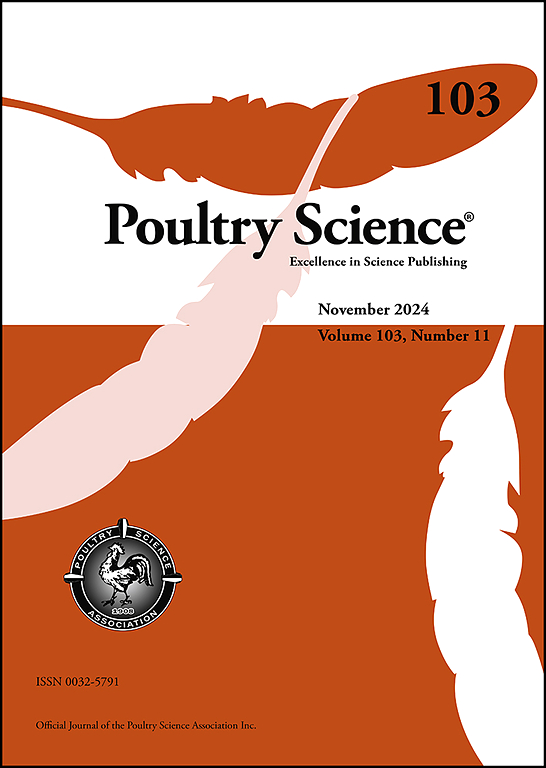通过优化育肥期淀粉脂比、可消化氨基酸和代谢能,最大限度地提高热应激肉鸡的生产性能。
IF 3.8
1区 农林科学
Q1 AGRICULTURE, DAIRY & ANIMAL SCIENCE
引用次数: 0
摘要
本试验旨在研究高淀粉脂比(S:L)、氨基酸密度(以可消化赖氨酸百分比表示)和AME配制的饲粮对热应激肉鸡生长性能和胴体特性的影响及其相互作用。采用{3,3}单纯形点阵设计来评估相对效果并生成预测模型。配制出3种S:L比最高的基础育肥猪饲粮(基础A;20:1), DigLys(基础B;1.30%)或AME(基础C;3300千卡/公斤)。这些饲粮按0.00、0.33、0.67和1.00的水平混合,共生产10种育肥性饲粮。该混合物允许不同的S:L比(4:1 ~ 20:1)、DigLys(0.80 ~ 1.30%)和AME (2800 ~ 3300 kcal/kg)含量。按性别分组(n = 6,864),罗斯708只肉鸡分房饲养(公母各5只),圈养密度为31 kg/m2。按性别分别饲喂起始日粮和生长日粮至21 d。在第21至27天,房间保持在21°C。从第27天到第32天,雏鸟遭受周期性热应激,12 h为31°C, 12 h为21°C,最低RH为50%。分别于第21、27、32天测定体重和饲料残重,计算体重增重(BWG)和料重比(F:G)。在第33天,每个性别每个处理宰杀20只鸡,以确定胴体特征。在这些条件下(第21 ~ 32天),当饲粮中添加42.2%的基础B和57.8%的基础C, S:L比为4:1,AME为3089 kcal/kg, DigLys为1.01%时,雄性体重最大可达926 g。热应激期间,饮食对雌性体增重无影响。虽然不可能给出最佳胸肉产量(活重%)和F:G比的实用建议,但结果表明,在热应激条件下,增加DigLys可改善这些参数。本文章由计算机程序翻译,如有差异,请以英文原文为准。
Maximizing the performance of heat stressed broilers by optimizing starch-to-lipid ratios, digestible amino acid, and metabolizable energy during the finisher phase
This study investigated the effects and interactions among diets formulated to have high starch-to-lipid ratios (S:L), amino acid density [indicated as % digestible lysine (DigLys)], and AME on growth performance and carcass characteristics of heat stressed broilers. A {3,3} simplex lattice design was used to assess relative effects and generate predictive models. Three basal finisher diets were formulated to have the highest S:L ratio (Basal A; 20:1), DigLys (Basal B; 1.30 %), or AME (Basal C; 3300 kcal/kg). These diets were blended at levels of 0.00, 0.33, 0.67, or 1.00 to produce 10 finisher diets. The mixtures allowed varying S:L ratios (4:1 to 20:1), DigLys (0.80 to 1.30 %), and AME (2800 to 3300 kcal/kg) content of diets. sex-separated (n = 6,864) Ross 708 broiler chicks were placed in separate rooms (5 male and 4 female) with a pen stocking density of 31 kg/m2. Sex-specific starter and grower diets were fed until d 21. The rooms were maintained at 21°C during d 21 to 27. From d 27 to 32, the birds were subjected to cyclical heat stress, with 12 h of 31°C followed by 12 h of 21°C, with a minimum RH of 50 %. BW and feed residual weights were measured on d 21, 27, and 32, then used to calculate BW gain (BWG) and feed-to-gain ratios (F:G). On d 33, 20 birds per treatment per sex were slaughtered to determine carcass characteristics. Under these conditions (d 21 to 32), maximum male BWG of 926 g was estimated to occur when fed a diet comprised of 42.2 % Basal B and 57.8 % Basal C with a S:L ratio of 4:1, AME of 3089 kcal/kg, and 1.01 % DigLys. Diet did not influence female BWG during heat stress. Although a practical recommendation was not possible for optimal breast meat yield (% live weight) and F:G ratios, the results, indicated that increasing DigLys would improve these parameters under heat stress.
求助全文
通过发布文献求助,成功后即可免费获取论文全文。
去求助
来源期刊

Poultry Science
农林科学-奶制品与动物科学
CiteScore
7.60
自引率
15.90%
发文量
0
审稿时长
94 days
期刊介绍:
First self-published in 1921, Poultry Science is an internationally renowned monthly journal, known as the authoritative source for a broad range of poultry information and high-caliber research. The journal plays a pivotal role in the dissemination of preeminent poultry-related knowledge across all disciplines. As of January 2020, Poultry Science will become an Open Access journal with no subscription charges, meaning authors who publish here can make their research immediately, permanently, and freely accessible worldwide while retaining copyright to their work. Papers submitted for publication after October 1, 2019 will be published as Open Access papers.
An international journal, Poultry Science publishes original papers, research notes, symposium papers, and reviews of basic science as applied to poultry. This authoritative source of poultry information is consistently ranked by ISI Impact Factor as one of the top 10 agriculture, dairy and animal science journals to deliver high-caliber research. Currently it is the highest-ranked (by Impact Factor and Eigenfactor) journal dedicated to publishing poultry research. Subject areas include breeding, genetics, education, production, management, environment, health, behavior, welfare, immunology, molecular biology, metabolism, nutrition, physiology, reproduction, processing, and products.
 求助内容:
求助内容: 应助结果提醒方式:
应助结果提醒方式:


